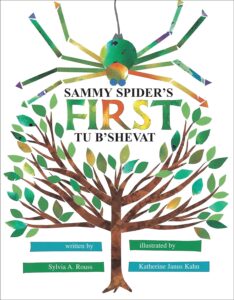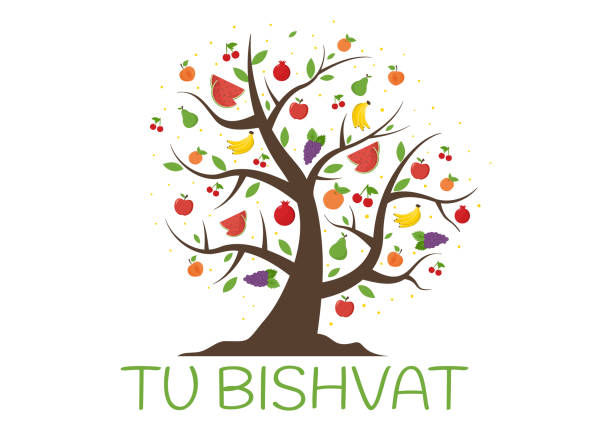Tu B’Shevat, the “birthday of the trees”, begins soon.

Tu B’Shevat Background
Tu B’Shevat, which literally means the 15th of the month of Shevat, celebrates the new year or birthday of the trees. In the secular calendar, the holiday occurs sometime between the end of January and the beginning of February. This holiday is celebrated outdoors. Saplings are planted, nuts and fruit are eaten, and trees are honored for what they contribute to our lives. Although there is no mention of this holiday in the Torah, during biblical times farmers counted their trees for the tax assessor on this day. Later it became a tradition to plant a tree on this day to celebrate the birth of a child, a cedar for a boy and a cypress for a girl. When the child married, the branches of the tree were used to hold up the wedding canopy. More recently, when Jews returned to resettle the land of Israel, they found the country was mostly swamp and desert. An effort was made to reforest the land and make it fertile once again. The Jewish National Fund created a campaign that encourages people to plant trees in Israel to celebrated important events. As a result, millions of trees have been replanted and continue to be planted in Israel. The almond tree has become a symbol of Tu B’Shevat as it is the first tree to blossom in Israel after the winter season. Many other fruits indigenous to the land of Israel—figs, pomegranate, dates, carob—-are eaten as well.
SEVEN ACTIVITIES FOR THE HOLIDAY
1. Discuss where plants come from. Allow children to express their ideas. (A seed is a plant that has not started to grow. When the seed is moistened, a root starts to grow. Little roots grow from the big root, they look like tiny hairs. Soon a shoot pushes through the ground. It is the beginning of a green plant. The leaves come next, then the flower).
2. Plant seeds and let children observe the growing process.
3. Read books about plants and trees (ie: The Giving Tree, A Tree is Nice, Sammy Spider’s First Tu B’Shevat, The Littlest Tree, In My Garden, The Great Kapok Tree, The Carrot Seed, Growing Vegetable Soup)
4. Taste a variety of fruits and nuts. Compare taste, texture, appearance, smell, and listen to the sound they make when you eat them.
5. Take children outdoors and let them draw pictures of trees, flowers, and other plants.
6. Discuss how trees help us—lumber for building, fuel, shade, fruit to eat, home for birds and animals.
7. Tu B’Shevat is a good time to make children aware of the environment. Discuss ways in which to protect trees—Don’t tear bark away, don’t break branches, don’t break roots, watch out for harmful insects that hurt trees, don’t waste the resources we get from trees. Use Tu B’Shevat to create environmental awareness.


FROM A PRESCHOOL TEACHER: This week we have been getting ready for Tu B’Shevat, the Birthday of the Trees!!! We read Sammy Spider’s First Tu B’Shevat by Sylvia Rouss. The children love Sammy! They know a special Holiday is coming every time we read a story about him. This story talked about the seasons. We observed how different the trees looked as the seasons changed and what animals lived there and the different kinds of food the trees provided. We talked allot about all of the things that trees give to us. Our chairs, paper, snack foods, even toilet paper come from trees. We discussed how you should only use “just enough” of things like toilet paper and other disposable products. We don’t want to waste our trees! We made letter T trees for Tu B’Shevat and made a beautiful forest on our wall.
Click Here for Original Songs for Tu B’Shevat
TU B’SHEVAT LEARNING GAMES
1. MATCHING SETS TO NUMBERS – Cut six slits into the lid of a shoebox. Number the slits 1-6. Cut 6 tree shapes out of construction paper, draw from 1-6 sets of dots on each tree, laminate, and glue them to craft sticks. Have children take turns “planting” the trees into the matching numbered slot in the shoebox lid.
2. MATCHING SETS TO NUMBERS – Cut five squares out of cardboard. On each square, glue a leafy tree shape cut from green felt. Write a numeral from 1 to 5 under each tree. Cut 15 small apple shapes out of red felt. Set out the tree cards and apple shapes. To play, have a child identify the numerals beneath the trees and place matching numbers of apples on the trees.
3. SPATIAL RELATIONSHIPS – Set out a large box filled with sand. Cut flower shapes out of construction paper and attach them to craft sticks. Let child plant the flowers in the sandbox as you give directions such as these: “Plant the flowers side by side in two rows, plant a flower in the corner of the box, plant one flower next to another flower, plant one flower behind another flower, plant two flowers in the middle of the box.”
Readers may wish to re-visit my two posts by clicking on either paragraph:

